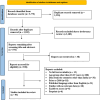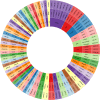Prevalence and associated risk factors of overweight and obesity among adolescent population of India: a scoping review
- PMID: 40474315
- PMCID: PMC12139068
- DOI: 10.1186/s40795-025-01088-0
Prevalence and associated risk factors of overweight and obesity among adolescent population of India: a scoping review
Abstract
Background: Adolescent obesity and overweight is a global epidemic, resulting in severe health problems such as dyslipidemia, hypertension, diabetes, and coronary heart disease. With the rising prevalence of overweight and obesity among Indian adolescents, it is crucial to examine the existing status of research/evidence and the gaps in research. Therefore, the present scoping review was conducted to map the evidence on the prevalence of adolescent obesity/overweight in India and associated major risk factors.
Methods: The study followed Arksey and O'Malley's (2005) scoping review framework and Joanna Briggs Institute Reviewers Manual (2015) recommendations. We undertook the literature search in electronically available databases using specific mesh terms.
Results: We identified 93 studies that met the standard inclusion criteria. The prevalence of overweight ranged from 1.25 to 35.8% (male: 2.6-28.1%; female: 2.7-44.5%), while obesity ranged from 0.3 to 24.6% (male: 1-19.7%; female: 0.3-32.8%). Research activity peaked between 2011 and 2020, with the highest number of publications in 2015 (n = 13). Most studies were conducted in southern states (31%), followed by eastern (16%), western (15%), and northern (12.9%) regions. A significant proportion were urban-based (70.9%) and institution-based (77.4%). Among major key risk factors, insufficient physical activity was examined in 36.5% of studies, high-calorie dietary habits in 44% of the studies, higher socioeconomic status was reported in 36.5% of studies. Additionally, 26.8% of studies explored the impact of factors like urban living, private school attendance and increased screen time as associated factors of weight gain among adolescents. Other identified factors included 12.9% reporting using vehicles for school transportation, 8.6% noting shorter sleep duration, and 17.2% recognizing a family-history of overweight and obesity as contributing factors.
Conclusion: The review provides a comprehensive overview of adolescent obesity and overweight in the Indian context while highlighting critical research gaps for future exploration. Most studies are cross-sectional and quantitative, underscoring the need for longitudinal and qualitative research. There is a lack of studies on gender-specific risk factors, community-based perspectives, and vulnerable populations such as slum-dwelling adolescents and school dropouts. Addressing these gaps will be essential for generating robust evidence to inform and implement effective, evidence-based policies and interventions.
Keywords: Adolescent health risk behavior; Adolescent nutrition; Childhood overweight and obesity; Children and adolescent health, Indian adolescents; Evidence synthesis.
© 2025. The Author(s).
Conflict of interest statement
Declarations. Ethical approval: This scoping review does not require ethical approval; it involves a systematic combination and presentation of available resources. Consent for publication: Not applicable. Competing interests: The authors declare no competing interests.
Figures



Similar articles
-
Folic acid supplementation and malaria susceptibility and severity among people taking antifolate antimalarial drugs in endemic areas.Cochrane Database Syst Rev. 2022 Feb 1;2(2022):CD014217. doi: 10.1002/14651858.CD014217. Cochrane Database Syst Rev. 2022. PMID: 36321557 Free PMC article.
-
The effectiveness of web-based programs on the reduction of childhood obesity in school-aged children: A systematic review.JBI Libr Syst Rev. 2012;10(42 Suppl):1-14. doi: 10.11124/jbisrir-2012-248. JBI Libr Syst Rev. 2012. PMID: 27820152
-
Screening and Interventions for Childhood Overweight [Internet].Rockville (MD): Agency for Healthcare Research and Quality (US); 2005 Jul. Rockville (MD): Agency for Healthcare Research and Quality (US); 2005 Jul. PMID: 20722132 Free Books & Documents. Review.
-
The incidence, prevalence, and contributing factors of overweight and obesity among adolescent population of India: A scoping review protocol.PLoS One. 2022 Sep 26;17(9):e0275172. doi: 10.1371/journal.pone.0275172. eCollection 2022. PLoS One. 2022. PMID: 36156092 Free PMC article.
-
Behavioral and Pharmacotherapy Weight Loss Interventions to Prevent Obesity-Related Morbidity and Mortality in Adults: An Updated Systematic Review for the U.S. Preventive Services Task Force [Internet].Rockville (MD): Agency for Healthcare Research and Quality (US); 2018 Sep. Report No.: 18-05239-EF-1. Rockville (MD): Agency for Healthcare Research and Quality (US); 2018 Sep. Report No.: 18-05239-EF-1. PMID: 30354042 Free Books & Documents. Review.
References
-
- Phelps NH, Singleton RK, Zhou B, Heap RA, Mishra A, Bennett JE, Paciorek CJ, Lhoste VP, Carrillo-Larco RM, Stevens GA, Rodriguez-Martinez A. Worldwide trends in underweight and obesity from 1990 to 2022: a pooled analysis of 3663 population-representative studies with 222 million children, adolescents, and adults. Lancet. 2024;403(10431):1027–50. - PMC - PubMed
-
- World Health Organization. Obesity and overweight: Key facts. 2024 Mar. Available from: https://www.who.int/news-room/fact-sheets/detail/obesity-and-overweight. Accessed 28 dec 2024.
-
- Smith KB, Smith MS. Obesity statistics. Prim Care. 2016;43(1):121–35. - PubMed
-
- World Health Organization. Noncommunicable diseases: childhood overweight and obesity. Geneva: WHO; 2020.
-
- World Obesity Federation. World Obesity Atlas 2023. 2023. Available from: https://www.worldobesity.org/resources/resource-library/world-obesity-at.... Accessed 28 dec 2024.
LinkOut - more resources
Full Text Sources
Miscellaneous
